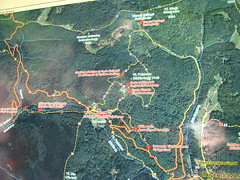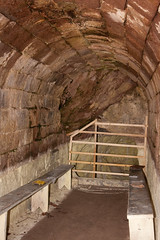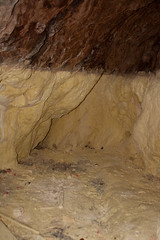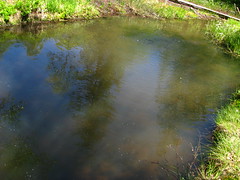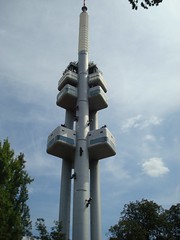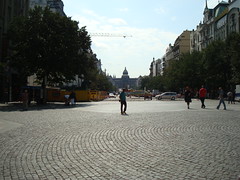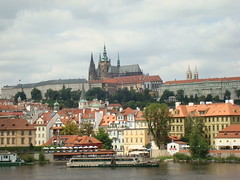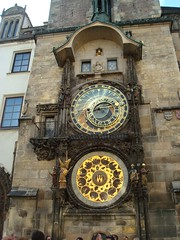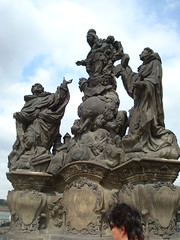Versiunea română aici.
I told you last year about the wonderful time we had at Băile Tușnad. This year, we decided to return to that part of the country to run and to do some hiking. You will find the practical information in the older article, so I won’t return to that.
There are a whole lot of trails in the volcanic mountains around Tușnad (see the maps above), but since we only had a half-day at our disposal, we decided to concentrate on two parts: Tinovul Mohoș (the Mohoș Marsh) and Masivul Puturosu (Puturosu -Smelly- mountain) with its sulfurous caves and its own Marsh, called Buffogo.
Tinovul Mohoș is a „reversed marsh”, as the guide put it: at the last volcanic eruption in the region, a layer of solidified lava landed on a lake. On this layer, small plants began to grow, forming an ever thicker layer of soil. The soil is much like a sponge – if you step on it, a hole appears, w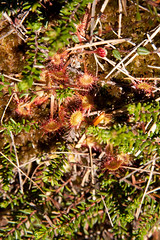 hich quickly fills with water. Depending on its thickness, different plants can grow on it: at the edge of the lake grow real trees, while in the middle only small pines and flowers can survive. What’s interesting is that one of the species of plant here is carnivore (see the photo on the right). The small drops on it are the poison that dissolves the insects it consumes.
hich quickly fills with water. Depending on its thickness, different plants can grow on it: at the edge of the lake grow real trees, while in the middle only small pines and flowers can survive. What’s interesting is that one of the species of plant here is carnivore (see the photo on the right). The small drops on it are the poison that dissolves the insects it consumes.
The access to this area is only allowed with a guide. The tours leave every hour and cost 3 RON (1,5 for children). Consider another 5 RON/car for parking.
The other area we visited is accessible from the Best Western hotel in Balvanyos. Take the road from Bixad to Sf. Ana, but instead of turning left at the crossroad, turn right and go for another 2 km, then park at the hotel. From there, just follow the track marked with a blue circle (see the second map above). It will take you to all the interest points on that mountain.
Unlike most of the peaks around it, Puturosu Mountain (1143 m) is formed mostly by sedimentation, with some areas, like the 60m wall near the Sulfurous Cave, where magma intruded during the last volcanic eruption.
The gas emanation from the mountain are the southernmost appearance of the volcanic elements in the Carpathians. Unlike other similar emanations, this one does not only contains carbon dioxide, but also hydrogen sulfide, which is responsible for the yellow deposits on the walls of the caves – see the images below. The gas is present to about 1m from the ground (as high as the color on the walls 🙂 ), and it has an almost instantaneous effect if you go below that height.
If you take the trail around the mountain clockwise, the first cave is also the most famous one, called simply „The Sulfurous Cave” (the first image from the left). It’s an old sulfur mine. When smelling the level of gas, one can’t help wonder how were the miners surviving in that hole?
Going forward around the mountain, you will get to a second cave, called Timsós Cave (the image from the middle). This one has a smaller opening, but is much deeper, and it goes down vertically, which means it is filled with poisonous gas.
From there on, the trail becomes very narrow and slippery. People with fear of heights should avoid it. During rainy periods, you should be well prepared if you are going that way. If you’re unsure, it’s better to go back and take the other way around the mountain.
If you continue, you will end up going to a forest so dense it will remind you of all the jungle movies you have ever seen. 🙂
In the end, you will reach a new crossroad. If you go to the left, you return to the hotel. It’s much more interesting to go forward, to the Buffogó Marsh. This is much smaller than Mohoș Marsh, but the water is much closer to the surface, and there is no guide. This means that you will end up full of mud, but it’s also much more fun.
The flowers in the Marsh are the same as in Mohoș, but a striking difference are the gases that escape from the water, making it look like it boils (the picture from the right).
After you’ve had enough of the mud, go back to the crossroad and take the trail back to the hotel. On the way, don’t forget to stop by the Birds’ Cemetery and the Killer Cave. The cemetery is a valley filled with gas, where many birds, but also mammals have died. The Killer Cave, just next to it, is the biggest of all the caves on the mountain. It’s called Killer because there is no sulfur deposit on the cave walls, which means there is no warning on the gases inside. You can still see dead bats inside if you have a light with you.
From now on, the rest of the road is just going around the mountain and ending at the hotel.
At the end of the trip, you can return and enjoy a panorama of the Sf. Ana lake:

